Introduction and Quick Summary
Classic deviled eggs are a timeless appetizer that never fails to impress. Whether you’re hosting a holiday gathering or simply want a tasty snack, this dish is an excellent choice. The creamy yolk filling paired with the slight tang of mustard creates a delightful flavor profile that tantalizes the taste buds. In this recipe, we’ll not only guide you through making classic deviled eggs but also share tips to elevate your presentation.
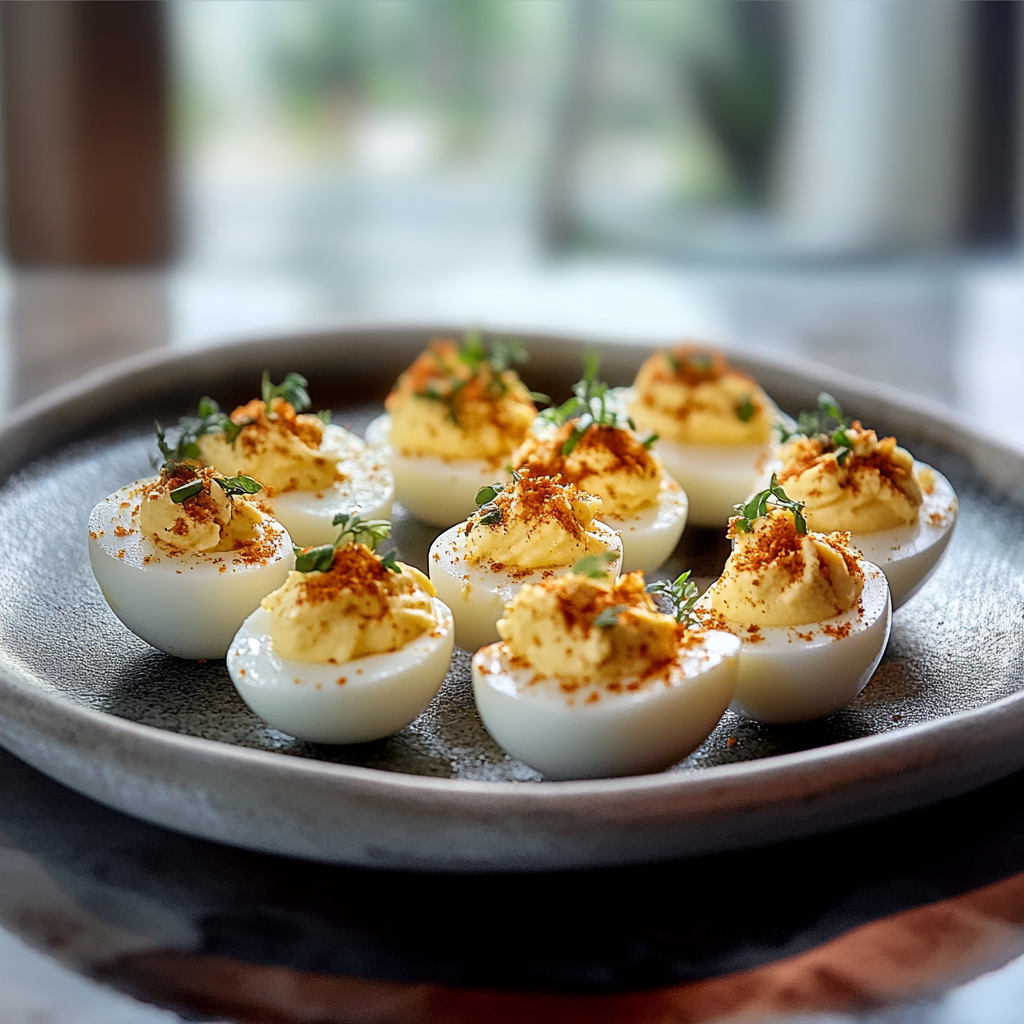
Deviled eggs originate from ancient Rome but became popular in America during the mid-20th century. Their versatility allows for numerous variations, yet the classic version remains a favorite. This recipe focuses on simplicity while ensuring maximum flavor. With just a handful of ingredients and minimal preparation time, you can whip up these delicious bites in no time.
In this article, we’ll break down the main ingredients required for this dish, provide detailed step-by-step instructions for preparing the perfect classic deviled eggs, and offer serving and storing tips to ensure your dish is as fresh as possible. Get ready to impress your guests with an appetizer that’s both easy to make and universally loved!
Main Ingredients
Eggs
Eggs are the star ingredient in classic deviled eggs. For this recipe, you’ll need six large hard-boiled eggs. The quality of the eggs matters; using fresh organic or free-range varieties enhances flavor. To achieve perfectly hard-boiled eggs, simmer them gently rather than boiling vigorously to avoid rubbery whites.
Mayonnaise
Mayonnaise adds creaminess to your filling. You’ll need about three tablespoons for this recipe. Using high-quality mayonnaise can elevate the overall taste of your classic deviled eggs. You may choose store-bought or homemade mayonnaise depending on your preference. The mayonnaise balances out the egg’s richness and provides moisture.
Mustard
A teaspoon of yellow mustard brings tanginess to the filling mixture. This ingredient is essential for achieving that distinct flavor that defines classic deviled eggs. You can experiment with different types of mustard like Dijon or spicy brown if you prefer more complexity in taste.
Salt and Pepper
Seasoning is key to bringing out flavors in any dish. Use about one-fourth teaspoon of salt and a pinch of black pepper in your filling mixture. These simple seasonings enhance the overall taste without overwhelming it. Adjust according to personal preference; always taste before serving.
Paprika
Paprika is used not only for flavor but also for garnish. A light sprinkle on top adds color and visual appeal to your classic deviled eggs. Use around one-eighth teaspoon for mixing into the filling and another pinch for garnishing before serving.
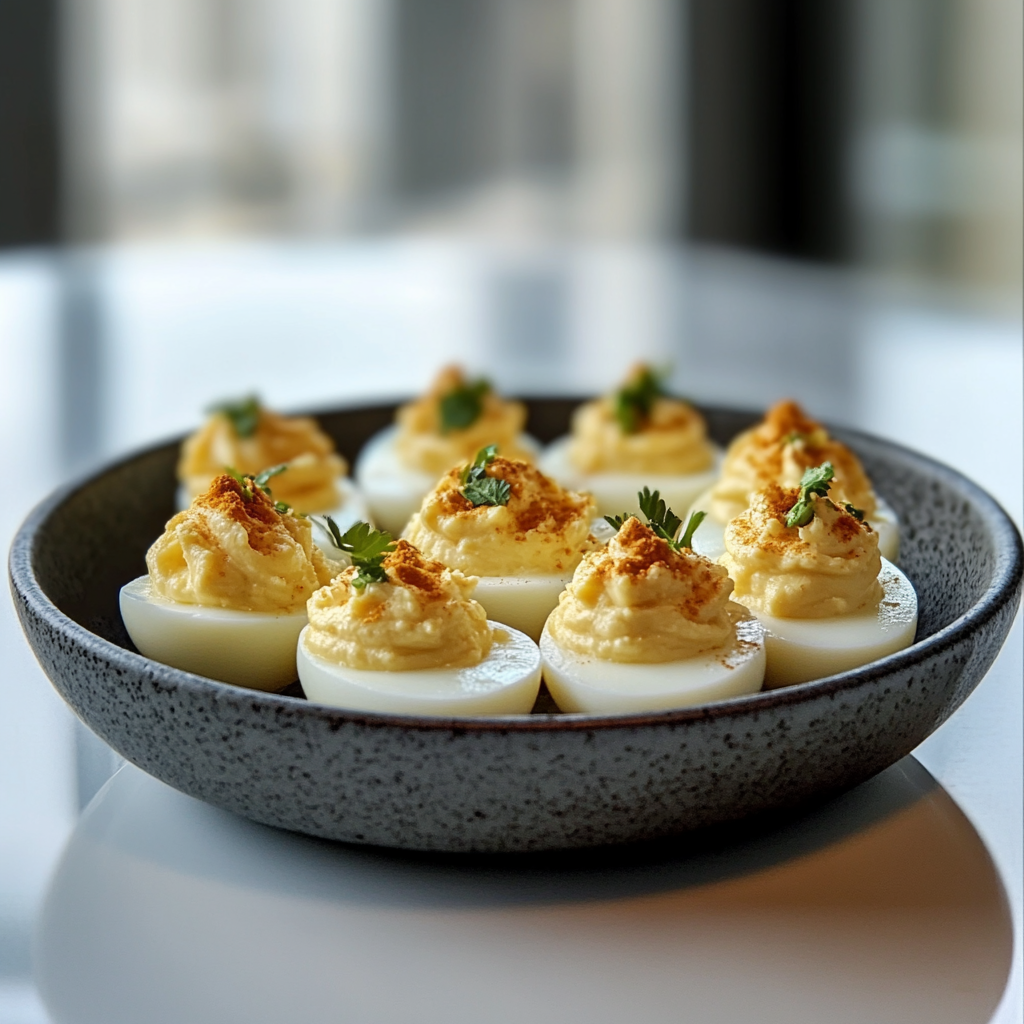
How to Prepare Classic Deviled Eggs
Step 1: Hard Boil Your Eggs
To start making classic deviled eggs, first prepare your hard-boiled eggs correctly. Place six large cold eggs in a pot and cover them with cold water by an inch or so above the egg level. Bring the water to a boil over medium-high heat once it reaches boiling point; cover the pot with a lid and remove it from heat immediately. Let it sit undisturbed for 12 minutes, allowing them to cook through gently without overcooking.
After 12 minutes, transfer the eggs into an ice-water bath for at least five minutes; this helps stop cooking and makes peeling easier later on. Once cooled down thoroughly, gently tap each egg against a hard surface to crack its shell then roll it between your hands lightly to loosen it before peeling under running water for easier shell removal.
Step 2: Prepare The Filling
Once peeled, slice each egg in half lengthwise using a sharp knife carefully—this ensures clean cuts without damaging the whites’ structure too much. Gently remove yolks from each half into a mixing bowl while keeping whites intact—place them aside on a serving platter once all yolks have been transferred.
Mash yolks with a fork until they become crumbly then add three tablespoons of mayonnaise along with one teaspoon of yellow mustard into the bowl containing yolks now mix everything together thoroughly until smooth consistency achieved—you may add more mayo if desired creaminess isn’t reached yet! Season mixture with salt (about one-fourth teaspoon) pepper (pinch) adjusting according to taste preferences; remember always taste before proceeding further!
Step 3: Fill The Egg Whites
Now that you’ve prepared your yolk filling it’s time to fill those egg white halves back up! You can utilize either two teaspoons or piping bag fitted with star-shaped nozzle—a piping bag allows more elegant presentation if desired! If using teaspoons scoop generous amounts of filling into each egg white half ensuring they are filled levelly but not overflowing creating slight mounds instead!
Repeat until all whites are filled evenly then proceed by sprinkling paprika generously over tops adding final touch presentation-wise—this will give not only color contrast but also hint spice-wise upon first bite! Once finished place them back onto serving plate ready enjoy!
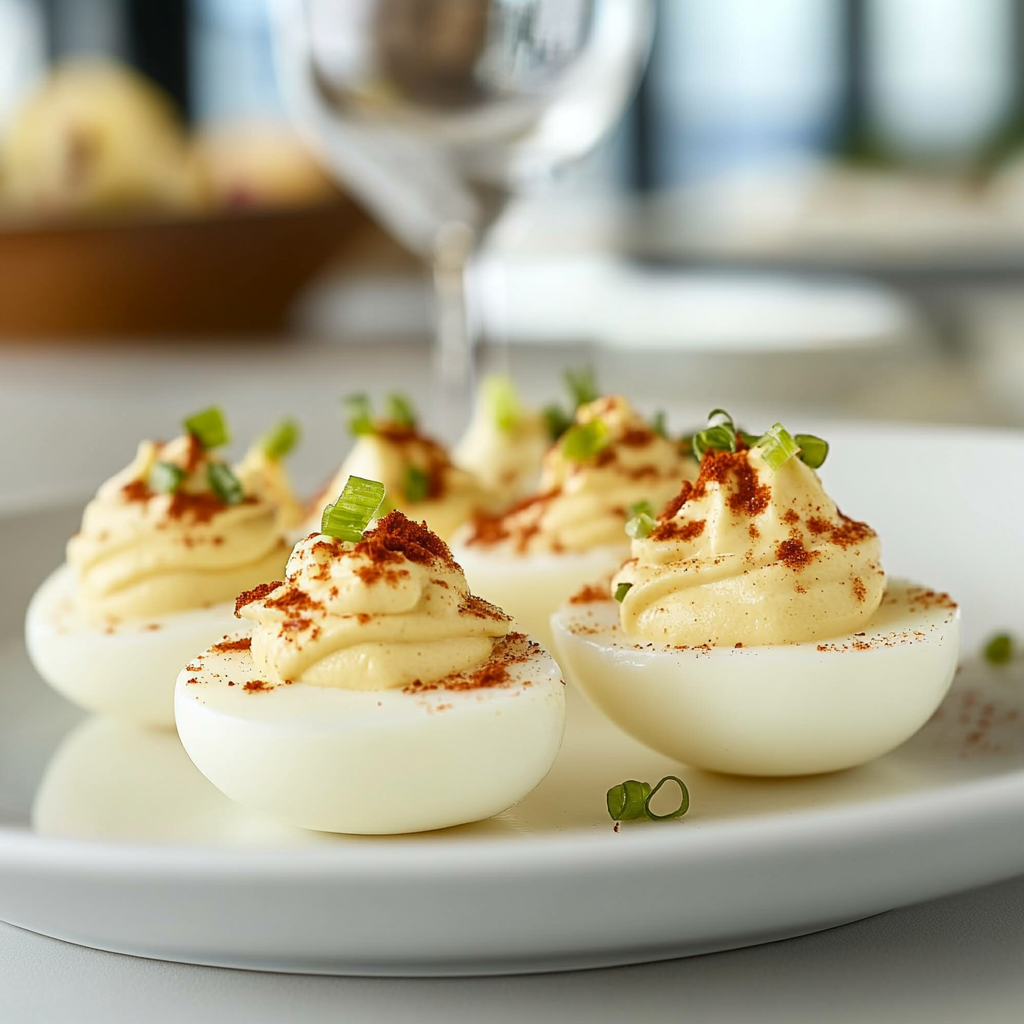
Serving and Storing Tips
Serving Suggestions
Classic deviled eggs make an excellent finger food option at parties or gatherings! Serve them chilled on their own or pair alongside crunchy vegetables such as celery sticks for added texture contrast—this combination offers colorful plates while catering different tastes amongst guests! Consider garnishing additional toppings such as chopped chives bacon bits dill sprigs olives depending preference elevating flavors even further showcasing creativity within presentation!
For best results serve immediately after preparing allowing flavors settle enhancing experience overall—they stay fresh up four hours refrigerated prior serving so plan accordingly! Arrange beautifully on platters use decorative touches garnishing surrounding area creating inviting atmosphere enticing everyone indulge these delectable bites!
Storing Leftovers
If you happen to have leftover classic deviled eggs after enjoying them don’t worry—they store well too! Place any uneaten portions inside airtight container lined paper towels absorb moisture ensuring freshness longer periods avoid sogginess affecting texture when stored properly they last up two days refrigerator without compromising quality retain original flavors still intact!
Before storing remember cover each egg half tightly using plastic wrap foil preventing exposure air which leads drying out—if possible avoid stacking them directly atop one another protecting delicate fillings from damage! When ready consume simply take out fridge allow sit room temperature around ten minutes regain ideal eating temperature enjoy flavorful treats once again!
By following these easy steps you’ll create mouthwatering classic deviled eggs perfect every occasion delighting guests family alike everyone will love indulging these wonderful appetizers!
Mistakes to avoid
One of the most common mistakes when making classic deviled eggs is overcooking the eggs. When eggs are boiled for too long, they develop a greenish ring around the yolk and can become rubbery in texture. To avoid this, boil your eggs for exactly 9-12 minutes depending on the size of your eggs. After boiling, immediately transfer them to an ice bath to stop the cooking process. This not only helps maintain a creamy yolk but also makes peeling easier.
Another mistake is not seasoning adequately. Classic deviled eggs require a well-balanced mixture of ingredients to enhance flavor. Some people may forget to add salt or pepper, which can lead to bland results. It’s essential to taste the filling as you mix it, adjusting seasoning as needed. Adding mustard or vinegar also helps in achieving that tangy flavor profile that classic deviled eggs are known for.
Using old eggs is another pitfall that can jeopardize your dish. Fresh eggs tend to be harder to peel, leading to unsightly egg whites with bits missing. Instead, use slightly older eggs, as they tend to peel more easily while still providing good flavor and texture. Always check the expiration date before you begin cooking.
Lastly, neglecting presentation can diminish the appeal of your classic deviled eggs. A simple garnish like paprika or fresh herbs elevates the visual impact and adds extra flavor. Take a moment to carefully pipe or spoon the yolk mixture into the egg white halves and consider using a piping bag for a professional touch.
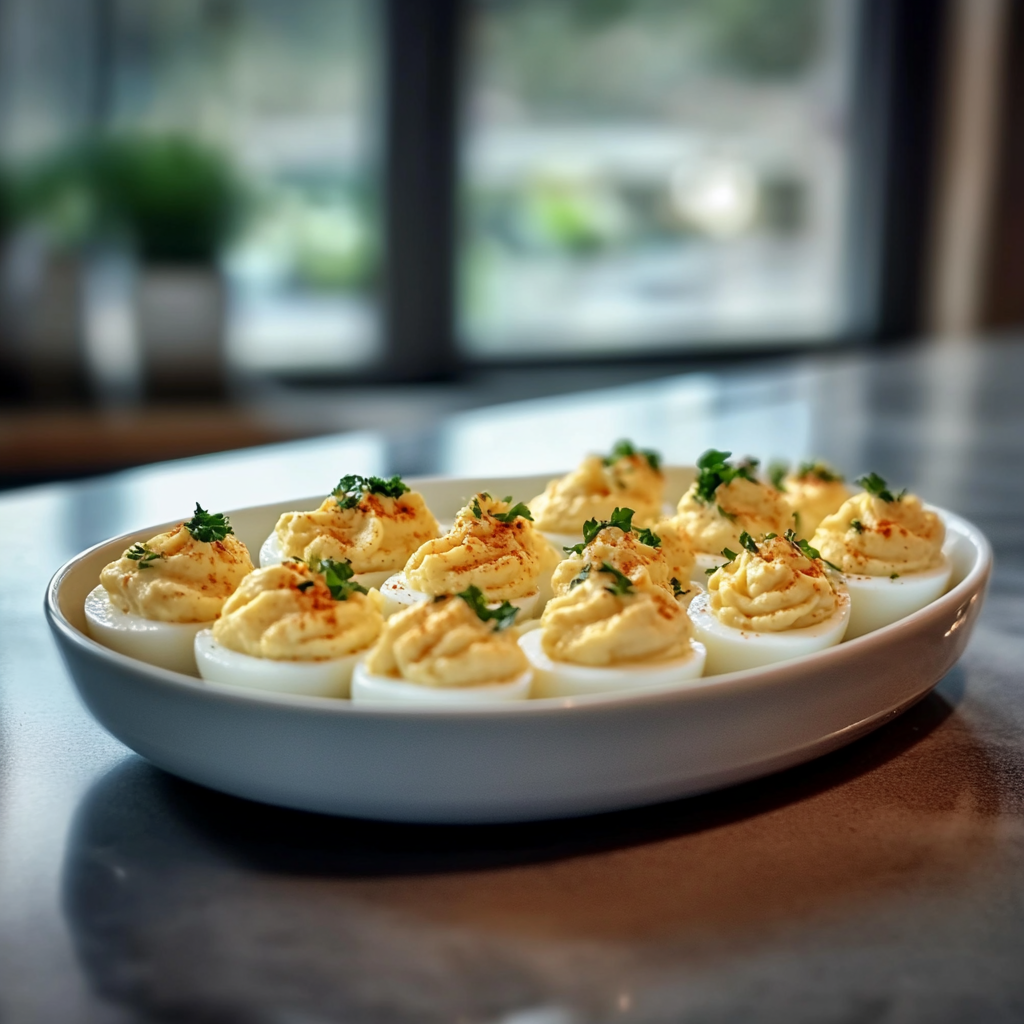
Tips and tricks
To create perfect classic deviled eggs every time, start with quality ingredients. Use organic or free-range eggs if possible; they often have richer flavors and better textures. The mayonnaise you choose also matters—opt for a high-quality product or even homemade mayo for enhanced creaminess and taste.
When mixing your yolks with other ingredients, aim for a smooth consistency. If you find lumps in your filling, pass it through a fine-mesh sieve or use an immersion blender for a more refined texture. This step ensures that each bite is silky and delightful, characteristics that define great classic deviled eggs.
For those looking to add a twist without straying from tradition, consider incorporating unique ingredients such as avocado or bacon bits into the yolk mixture. These additions can offer exciting variations while maintaining the essence of classic deviled eggs.
Don’t forget about chilling! Once prepared, refrigerate your classic deviled eggs for at least 30 minutes before serving. This allows flavors to meld together beautifully and ensures that they are served cold—a crucial aspect of enjoying this dish fully.
Finally, always prepare more than you think you’ll need! Classic deviled eggs tend to disappear quickly at gatherings or parties. By making a larger batch than planned, you ensure everyone gets their fill—and perhaps leave some for yourself!
Suggestions for Classic deviled eggs
When preparing classic deviled eggs, temperature control plays an important role in achieving optimal results. Ensure all ingredients are at room temperature before mixing them with the yolks; this will help achieve an even consistency in your filling without clumps forming from cold ingredients. Room temperature mayonnaise spreads easily and blends seamlessly with egg yolks.
Experimenting with garnishes can elevate your dish significantly as well. Beyond traditional paprika, consider using capers, chives, or even caviar for luxury touches that impress guests at any gathering. A sprinkle of smoked sea salt can also provide an intriguing flavor contrast that complements the creamy filling beautifully.
If you’re hosting events where dietary restrictions may arise, consider offering variations like vegan or gluten-free options alongside your classic deviled eggs. Substitute traditional mayonnaise with avocado-based spreads or tahini mixed with spices; these alternatives cater to different diets while still delivering delicious results.
Presentation matters! Use decorative serving platters or individual egg cups to showcase your classic deviled eggs elegantly on tables during gatherings or potlucks. Adding colorful veggies around the platter not only enhances aesthetics but serves as additional snacks for guests too.
Always remember food safety practices when preparing dishes like classic deviled eggs since they contain dairy products like mayonnaise which require proper storage methods after preparation to prevent spoilage. Keep them chilled until serving time and consume leftovers within 2 days if properly stored in airtight containers in refrigeration units.
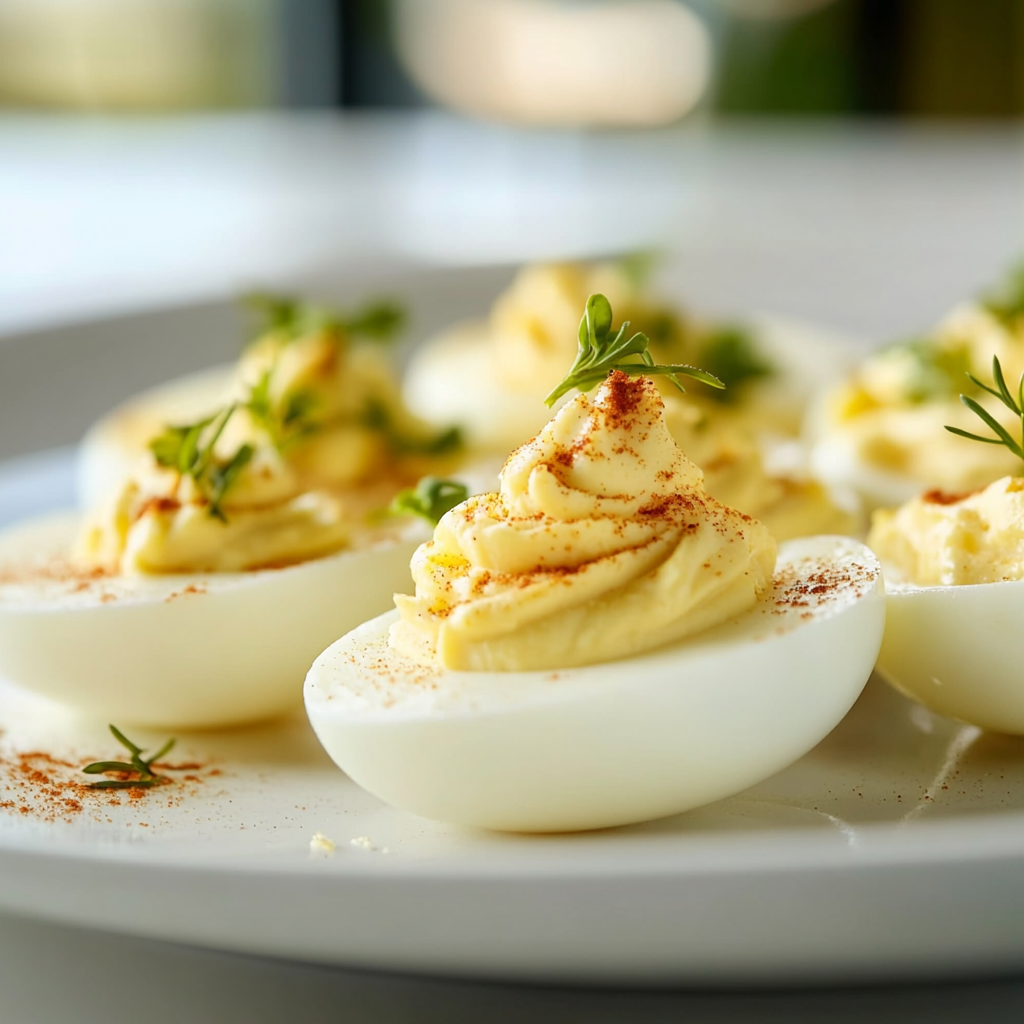
FAQs
What is the best way to boil eggs for classic deviled eggs?
Boiling perfect hard-boiled eggs requires precision and care. Start by placing cold water in a pot along with your desired number of large-sized fresh eggs—enough water should cover them by about an inch above their tops once submerged completely! Bring this water gently up toward boiling point over medium heat; once it reaches boiling (bubbles breaking consistently), cover tightly with lid while removing from direct heat source immediately! Let sit undisturbed between 9-12 minutes depending on size preference (for firm center). Following cook-time completion: transfer them promptly into ice bath until cooled completely before peeling shells off smoothly later!
How do I prevent my deviled egg filling from being too thick?
To achieve creamy consistency without excessive thickness when preparing fillings: start combining mashed yolks slowly into mayo/mustard mixes until desired texture achieved! If overly thickened after initial blending process—simply add small amounts of milk/cream/vinegar gradually (just teaspoons at first) until reaching preferred smoothness without compromising overall taste quality! Blending thoroughly after each addition prevents clumping while ensuring delightful creaminess remains intact!
Can I make classic deviled eggs ahead of time?
Absolutely! Preparing classic deviled egg dishes ahead saves valuable time during busy occasions like parties or family gatherings when entertaining guests becomes priority task! You may boil & prepare fillings one day prior—store separate components (egg whites & filled mixtures) within airtight containers inside fridges overnight until ready serve next day; just ensure everything remains cool prior plating presentation!
What are some popular variations of classic deviled egg recipes?
While traditional recipes reign supreme—many delightful twists exist catering tastes preferences worldwide! Some popular modifications include adding bacon bits/chopped olives/spicy sriracha sauce/avocado puree/dill pickles among others! Additionally experimenting various herbs like cilantro/tarragon brings interesting flavors into play without losing core essence behind beloved dish itself!
How should I store leftover classic deviled eggs?
Leftover servings must be stored diligently post consumption period—place uneaten portions inside airtight container lined parchment paper if available use plastic wrap directly covering surfaces too prevent drying out during refrigeration timeframe enjoyed within two days max duration keeping ideal freshness intact throughout storage lifecycle process ensuring maximum flavor enjoyment every single time!
Can I freeze my classical devilled egg leftovers?
Freezing isn’t recommended due potential textural changes occurring once thawed making them less appetizing upon consumption later down road; ideally best practice involves enjoying freshly made batches straight away preserving utmost quality integrity involved within culinary experience instead opting alternative snack ideas altogether if larger quantities remain unconsumed post-event duration!
Conclusion
Classic deviled eggs embody timeless charm and delightful flavor combinations that appeal across generations; however ensuring perfection requires diligence throughout cooking process itself—from selecting quality ingredients down effective preparation techniques implemented correctly along way! Avoiding common pitfalls such as overcooking/insufficient seasoning keeps those minor flaws at bay while enhancing texture ultimately nurtures overall satisfaction derived from dish served confidently amongst friends & family alike at events hosted regularly year-round—for those moments where tasty bites bring joy togetherness shared immensely appreciated by everyone present celebrating culinary delights made possible through simple yet flavorful recipes crafted lovingly kitchen environments everywhere enjoyed widely globally today still thriving evermore!
